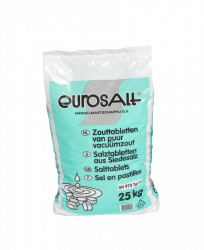Salt in Rotterdam
Rotterdam is a port city located in the west of the Netherlands, in the province of South Holland. The city is located on the Nieuwe Maas, one of the rivers in the delta formed by the Rhine and the Meuse. The port of Rotterdam, for a long time the largest in the world, is the largest and most important in Europe. The port area stretches over a length of 40 kilometres.[1]
The name Rotterdam dates from the thirteenth century and refers to a dam in the river Rotte. The historic city centre was largely destroyed by a German bombardment in May 1940. Rotterdam is known for its innovative architecture.
Sprinkle salt is also a widely accepted de-icing agent in Rotterdam. It lowers the freezing point of water. The salt (almost always sodium chloride, NaCl, sometimes calcium chloride, CaCl2) mixes with the present water (ice or snow) to form brine. Because brine has a lower freezing point than water, it will freeze less quickly so that less slipperiness occurs. After sprinkling salt, there must be sufficient traffic to get a good mixture. Brine is a mixture of water and salt. When a substance is dissolved in water, the freezing point of the solution drops. For example, if water contains 1 molal of sodium chloride, the freezing point will be lowered by about 1.86°C. The freezing point reduction can be calculated using cryoscopic constant. At lower and lower temperatures sodium chloride becomes less effective. To still melt ice, calcium chloride can be used, which is however much more expensive.
Wet salt in Rotterdam
Nowadays wet salt is mostly used. In that case, the spreading machine is equipped with liquid tanks (usually on the side), in which pre-mixed brine is stored. The dry salt is mixed with brine before it is released, where the salt grains clump together. The advantage of this is that the mixture is more homogeneous than dry salt, allowing it to be scattered much more accurately. In addition, much less dust is created behind the spreader. It is therefore possible for the spreader to drive faster, up to 70 km/h (against a maximum of 40 km/h with dry salt spreading). Wet salt also adheres better to the road surface due to crystallization and because wet salt blows less quickly, it is also suitable for preventive spreading.
Effects of brine in Rotterdam
Spreading salt is not without risk. For example, car bodies need to be well protected against oxidation because brine reacts strongly with metals.
Another influence is the salinization of the soil next to the road, which affects the flora's environment. For example, salt-loving plants, such as English grass, can be found along many roads, far from the coasts where they are normally found.
However, due to increasingly sophisticated equipment and new techniques, such as wet salt spreading, the accuracy with which the salt is brought onto the road has been greatly increased in recent years, which has resulted in a lower environmental impact. Not only is the dosage used a lot lower than before (often only 10 g/m2 is spread), also much less is spread on the verge.




